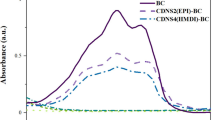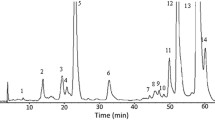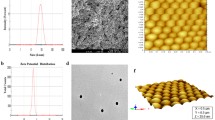Abstract
Beta-carotene (BC), a red-colored pigment found in plants and animals, is one of the most extensively investigated carotenoids due to its provitamin-A, antioxidant, and anticancer properties. The anticancer activity of BC through oral administration is severely affected due to its low bioavailability and oxidative degradation. The present study aimed to formulate and characterize solid lipid nanoparticles (SLNs) of BC for enhanced bioavailability and therapeutic efficacy. Beta-carotene-loaded solid lipid nanoparticles (BC-SLNs) were prepared employing different combinations of glyceryl monostearate and gelucire. The characterization studies were performed for particle size, morphology, release behavior, and stability. BC-SLNs were also studied for in vitro cytotoxicity in human breast cancer cell lines (MCF-7) and pharmacokinetic studies in Wistar rats. The cytotoxicity studies confirmed that encapsulation of BC within the lipid bilayers of nanoparticles did not affect its anticancer efficacy. An improved anticancer activity was observed in BC-SLNs as compared to the free BC. BC-SLNs enhanced the bioavailability of BC on oral administration by sustaining its release from the lipid core and prolongation of circulation time in the body. Similarly, area under the curve (AUCtotal) enhanced 1.92-times more when BC was incorporated into SLNs as compared to free BC. In conclusion, solid lipid nanoparticles could be an effective and promising strategy to improve the biopharmaceutical properties of carotenoids for anticancer effects.





Similar content being viewed by others
References
Abdulrahman GO, Rahman GA. Epidemiology of breast cancer in Europe and Africa. J Cancer Epidemiol Hindawi. 2012;2012:1–5.
Miele E, Spinelli GP, Miele E, Tomao F, Tomao S. Albumin-bound formulation of paclitaxel (Abraxane ABI-007) in the treatment of breast cancer. Int J Nanomedicine. 2009;4:99–105.
Khurana RK, Jain A, Jain A, Sharma T, Singh B, Kesharwani P. Administration of antioxidants in cancer: debate of the decade. Drug Discov Today Elsevier Current Trends. 2018;23:763–70.
Garg NK, Tyagi RK, Sharma G, Jain A, Singh B, Jain S, et al. Functionalized lipid–polymer hybrid nanoparticles mediated codelivery of methotrexate and aceclofenac: a synergistic effect in breast cancer with improved pharmacokinetics attributes. Mol Pharm. 2017;14:1883–97.
Lupulescu A. The role of vitamins A, beta-carotene, E and C in cancer cell biology. Int J Vitam Nutr Res. 1994;64:3–14.
Jain A, Thakur D, Ghoshal G, Katare OP, Shivhare US. Microencapsulation by complex coacervation using whey protein isolates and gum acacia: an approach to preserve the functionality and controlled release of β-carotene. Food Bioprocess Technol. 2015;8:1635–44.
Jain A, Sharma G, Kushwah V, Ghoshal G, Jain A, Singh B, et al. Beta carotene-loaded zein nanoparticles to improve the biopharmaceutical attributes and to abolish the toxicity of methotrexate: a preclinical study for breast cancer. Artif Cells Nanomed Biotechnol. 2018;23:1–11.
Jain A, Thakur D, Ghoshal G, Katare OP, Shivhare US. Characterization of microcapsulated β-carotene formed by complex coacervation using casein and gum tragacanth. Int J Biol Macromol. 2016;87:101–13.
Thakur D, Jain A, Ghoshal G, Shivhare U, Katare O. Microencapsulation of β-carotene based on casein/guar gum blend using zeta potential-yield stress phenomenon: an approach to enhance photo-stability and retention of functionality. AAPS PharmSciTech. 2017;18:1447–59.
Faulks RM, Southon S. Challenges to understanding and measuring carotenoid bioavailability. Biochim Biophys Acta. 2005;1740:95–100.
Jain AK, Jain A, Garg NK, Jain A, Jain SA, Tyagi RK, et al. Adapalene loaded solid lipid nanoparticles gel: an effective approach for acne treatment. Colloids surfaces B Biointerfaces. Elsevier BV; 2014;121:222–9.
Jain A, Kesharwani P, Garg NK, Jain A, Jain SA, Jain AK, et al. Galactose engineered solid lipid nanoparticles for targeted delivery of doxorubicin. Colloids Surf B Biointerfaces. 2015;134:47–58.
Garg NK, Singh B, Jain A, Nirbhavane P, Sharma R, Tyagi RK, et al. Fucose decorated solid-lipid nanocarriers mediate efficient delivery of methotrexate in breast cancer therapeutics. Colloids Surfaces B Biointerfaces. 2016;146:114–26.
Jain A, Garg NK, Jain A, Kesharwani P, Jain AK, Nirbhavane P, et al. A synergistic approach of adapalene-loaded nanostructured lipid carriers, and vitamin C co-administration for treating acne. Drug Dev Ind Pharm. 2016;42:897–905.
Jain A, Agarwal A, Majumder S, Lariya N, Khaya A, Agrawal H, et al. Mannosylated solid lipid nanoparticles as vectors for site-specific delivery of an anti-cancer drug. J Control Release. 2010;148:359–67.
Zur Mühlen A, Schwarz C, Mehnert W. Solid lipid nanoparticles (SLN) for controlled drug delivery--drug release and release mechanism. Eur J Pharm Biopharm Off J Arbeitsgemeinschaft fur Pharm Verfahrenstechnik eV. 1998;45:149–55.
Agarwal A, Majumder S, Agrawal H, Majumdar SP, Agrawal G. Cationized albumin conjugated solid lipid nanoparticles as vectors for brain delivery of an anti-Cancer drug. Curr. Nanosci. Bentham Science Publishers; 2011;7:71–80.
Jain A, Jain A, Parajuli P, Mishra V, Ghoshal G, Singh B, et al. Recent advances in galactose-engineered nanocarriers for the site-specific delivery of siRNA and anticancer drugs. Drug Discov Today.Elsevier Current Trends. 2017.
Schubert MA, Müller-Goymann CC. Solvent injection as a new approach for manufacturing lipid nanoparticles--evaluation of the method and process parameters. Eur J Pharm Biopharm. 2003;55:125–31.
Yi Y, Li Y, Wu H, Jia M, Yang X, Wei H, et al. Single-step assembly of polymer-lipid hybrid nanoparticles for mitomycin C delivery. Nanoscale Res Lett. 2014;9:560.
Jain A, Sharma G, Kushwah V, Thakur K, Ghoshal G, Singh B, et al. Fabrication and functional attributes of lipidic nanoconstructs of lycopene: an innovative endeavour for enhanced cytotoxicity in MCF-7 breast cancer cells. Colloids Surfaces B Biointerfaces. 2017;152:482–91.
Jain S, Jain AK, Pohekar M, Thanki K. Novel self-emulsifying formulation of quercetin for improved in vivo antioxidant potential: implications for drug-induced cardiotoxicity and nephrotoxicity. Free Radic Biol Med. 2013;65:117–30.
Jain AK, Thanki K, Jain S. Co-encapsulation of tamoxifen and quercetin in polymeric nanoparticles: implications on oral bioavailability, antitumor efficacy, and drug-induced toxicity. Mol Pharm. 2013;10:3459–74.
Jain A, Thakur D, Ghoshal G, Katare OP, Singh B, Shivhare US. Formation and functional attributes of electrostatic complexes involving casein and anionic polysaccharides: an approach to enhance oral absorption of lycopene in rats in vivo. Int J Biol Macromol. 2016;93:746–56.
Kharya P, Jain A, Gulbake A, Shilpi S, Jain A, Hurkat P, et al. Phenylalanine-coupled solid lipid nanoparticles for brain tumor targeting. J Nanopart Res. 2013;15:2022.
Cavallari C, Rodriguez L, Albertini B, Passerini N, Rosetti F, Fini A. Thermal and fractal analysis of diclofenac/Gelucire 50/13 microparticles obtained by ultrasound-assisted atomization. J Pharm Sci. 2005;94:1124–34.
de Oliveira Eloy J, Saraiva J, de Albuquerque S, Marchetti JM. Solid dispersion of ursolic acid in Gelucire 50/13: a strategy to enhance drug release and trypanocidal activity. AAPS PharmSciTech. 2012;13:1436–45.
Venkateswarlu V, Manjunath K. Preparation, characterization and in vitro release kinetics of clozapine solid lipid nanoparticles. J Control Release. 2004;95:627–38.
Agarwal A, Agrawal H, Tiwari S, Jain S, Agrawal GP. Cationic ligand appended nanoconstructs: a prospective strategy for brain targeting. Int J Pharm Elsevier BV. 2011;421:189–201.
Funding
This study received financial support from the University Institute of Pharmaceutical Sciences, Panjab University, Chandigarh, India, in the form of Jaswant Singh Gill Pharma Research Fellowship.
Author information
Authors and Affiliations
Corresponding authors
Ethics declarations
All the experimental procedures were carried out in accordance with institutional guidelines as indicated by the Institutional Animals Ethical Committee, Panjab University, Chandigarh, India, with prior approval (PU/IAEC/S/15/05).
Conflict of Interest
The authors declare that they have no conflict of interest.
Additional information
Guest Editor: Sanyog Jain
Publisher’s Note
Springer Nature remains neutral with regard to jurisdictional claims in published maps and institutional affiliations.
Rights and permissions
About this article
Cite this article
Jain, A., Sharma, G., Thakur, K. et al. Beta-carotene-Encapsulated Solid Lipid Nanoparticles (BC-SLNs) as Promising Vehicle for Cancer: an Investigative Assessment. AAPS PharmSciTech 20, 100 (2019). https://doi.org/10.1208/s12249-019-1301-7
Received:
Accepted:
Published:
DOI: https://doi.org/10.1208/s12249-019-1301-7




